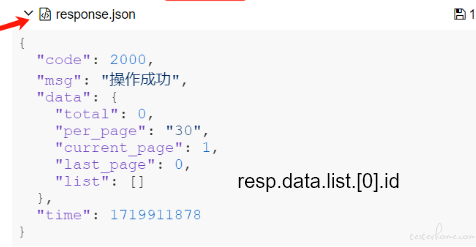-
2025 年总结 at 2025年11月25日
提前新婚快乐
-
katalon 有使用过的大佬吗? at 2025年03月12日
-
开发转测试想问一下各位在职大佬一些建议 at 2024年12月03日
快逃
-
【吐槽】低代码的接口自动化测试平台不好用 at 2024年10月10日
好像就叫 apitest,体验太差了,一个用例编辑就能有四层页面深度,实际用起来还是点得发昏,还好跑了
-
如何解决自动化切换数据库的问题 at 2024年09月03日
那听起来就是你们已经习惯了手写 mysql 的方式,按照加代理做语句替换的方式可能确实是最适合你们的,做好替换器的本地开发感觉是 ok 的
-
如何解决自动化切换数据库的问题 at 2024年09月02日
描述再详细点?看看现在的调用链路上的结构是咋样的
-
公司让我去做开发,我咋搞 at 2024年07月20日
上吧,练习写业务的绝佳机会,copilot 会告诉你答案
-
请教一个 pytest 中 fixture 相关问题:将 fixture 中写入 allure 附件的代码提出来定义成自定义方法后,就无法按预期写入 allure 附件了 at 2024年07月03日
能理解这个目的,那你这里毕竟把【数据位置】和具体的 json 实例 : resp.json()['data']['list'][0]['id'] 耦合在一起了,得重新设计一下才行
def get_value_by_path(json_data, path): for key in path: if isinstance(key, int) or key in json_data: json_data = json_data[key] else: return None return json_data # 传参 path def check_response(resp, path, expected_code=2000): allure.step("Check response status code and content") try: assert resp.status_code == 200, f"Expected status code 200 but got {resp.status_code}" assert resp.json()['code'] == expected_code, f"Expected code {expected_code} but got {resp.json()['code']}" # 通过path 拿到数据 return get_value_by_path(resp.json(), path) except (AssertionError,IndexError) as e: allure.attach( json.dumps(resp.json(), ensure_ascii=False, indent=2), name="response.json", attachment_type=allure.attachment_type.JSON ) allure.attach( resp.text, name="response.text", attachment_type=allure.attachment_type.TEXT ) raise AssertionError(f"Fixture: 断言失败") from e @pytest.fixture(scope="session", autouse=True) def tf_get_trainerId_xiehe(tf_getSession): url = Environment.HOST_ADMIN + 'managerList' data = {'page': 1, 'limit': 30, 'keys': Environment.userphone_tea, 'characterType': 1, 'roles': ''} resp = tf_getSession.post(url=url, data=data) # 自定义 【数据位置】 target_path = ['data', 'list', 0, 'id'] AssociatedDataTanQiang.id_xiehe_admin = check_response(resp,target_path) yield -
请教一个 pytest 中 fixture 相关问题:将 fixture 中写入 allure 附件的代码提出来定义成自定义方法后,就无法按预期写入 allure 附件了 at 2024年07月03日
# 传参去掉target_position def check_response(resp, expected_code=2000): allure.step("Check response status code and content") try: assert resp.status_code == 200, f"Expected status code 200 but got {resp.status_code}" assert resp.json()['code'] == expected_code, f"Expected code {expected_code} but got {resp.json()['code']}" # target_position在内部的异常处理内再显式调用 return resp.json()['data']['list'][0]['id'] except (AssertionError,IndexError) as e: allure.attach( json.dumps(resp.json(), ensure_ascii=False, indent=2), name="response.json", attachment_type=allure.attachment_type.JSON ) allure.attach( resp.text, name="response.text", attachment_type=allure.attachment_type.TEXT ) raise AssertionError(f"Fixture: 断言失败") from e @pytest.fixture(scope="session", autouse=True) def tf_get_trainerId_xiehe(tf_getSession): url = Environment.HOST_ADMIN + 'managerList' data = {'page': 1, 'limit': 30, 'keys': Environment.userphone_tea, 'characterType': 1, 'roles': ''} resp = tf_getSession.post(url=url, data=data) # 只传resp AssociatedDataTanQiang.id_xiehe_admin = check_response(resp) yield -
请教一个 pytest 中 fixture 相关问题:将 fixture 中写入 allure 附件的代码提出来定义成自定义方法后,就无法按预期写入 allure 附件了 at 2024年07月03日
这里不是 allure,fixture,异常处理等等特性的原因
简单理解一下
IndexError 就是越界异常,或者说下标找不到
你再看一下 checkresponse 这个入参
resp.json()['data']['list'][0]['id']
这个 resp 数据的 list 已经没有第 1 个 list,也没有 list 中的 id 了 -
请教一个 pytest 中 fixture 相关问题:将 fixture 中写入 allure 附件的代码提出来定义成自定义方法后,就无法按预期写入 allure 附件了 at 2024年07月03日

就是这么越界的吧 -
请教一个 pytest 中 fixture 相关问题:将 fixture 中写入 allure 附件的代码提出来定义成自定义方法后,就无法按预期写入 allure 附件了 at 2024年07月03日
check_response(resp,resp.json()['data']['list'][0]['id'])
是因为封装后,对 resp 的参数访问被放到了异常处理外层,然后报 IndexError 吗? -
Postman 自学及疑问(一)----globals。 at 2024年04月07日
disabled 是一个属性/成员变量
replacedin 确实是格式化输出字符串,你看你举得例子里不就是把 hereisakey 的值读进去了吗
看看这个文档
https://www.postmanlabs.com/postman-collection/VariableScope.html#replaceIn -
一个包含多个步骤的压力测试应该怎么用 Go 实现? at 2024年03月04日
不了解有什么不同的处理;但是不是这些处理都是系统运行时的一部分,也同时是你评估性能时要覆盖的场景呢?
-
一个包含多个步骤的压力测试应该怎么用 Go 实现? at 2024年03月04日
讨论一下关于第二点我的理解:
你预设的所谓分步骤压力测试与 chatgpt 理解的压力测试并不一致;
你认为解析 MQTT 信息是一个数据的处理,那说明你想评估的是连接 MQTT 的性能;
而 chatgpt 理解的是评估登录的性能,请求并解析 MQTT 的代理的步骤也是登录的一部分; -
Java 后端开发想转测试/测试开发?很迷茫,请各位大佬给个建议? at 2024年03月03日
你这个看起来是刚参加工作但无法适应工作;干测试解决不了你的问题
技术差写业务写不出来就利用互联网慢慢想
工作生活分不开你就多加班,加够了再去公园,街道散散步 -
除了 testerhome,还有哪些比较好的社区? at 2023年12月26日
V 站是哪,是 youtube 吗
-
已关闭 at 2023年11月09日
这我也没法给答复,我觉得也可以试试?
-
已关闭 at 2023年11月09日
一个 jd 多个部门用吧
,我在的组比较新,还缺人,大伙速来
-
小道消息高飞说云原生测试,音频已放出 at 2023年10月26日
完了,昨晚忘记了
-
Django 运行的时候报错了了 at 2023年09月26日
按报错信息看,可能是安装 django 的时候没有配环境变量。
按报错信息 You must either define the environment variable DJANGO_SETTINGS_MODULE or call settings.configure() before accessing settings.
来看,我找到了这个,应该可以解决你的问题https://www.cnblogs.com/LouisZJ/articles/9545898.html
也就是在代码主函数配置环境变量
'''
import osif name == 'main' :
os.environ.setdefault('DJANGO_SETTINGS_MODULE', 'django 路径/django 配置文件.settings' )
''' -
新手小白想问下学习路线 at 2023年09月25日
-
【讨论】工作了 1 年后时常陷入自我内耗中...... at 2023年09月20日
我也刚工作一年,正好在想自己的职业价值;目前工作可以带给我的提升。
在回帖里梳理一下自己的思路:- 招聘市场的反映是比较直观的
- 想想大佬跳槽时带来涨薪的是哪些能力
- 选择其中合适的深入学习
我恰好最近跳了一次,回头梳理一下,我觉得是这些能力提升带来的涨薪:
虽然都是微末的提升,但确实是比一年前长进的地方
- 对测试工程的理解加深,在工作中掌握了测试工程方法:
- 测试工作的目的是什么:产品质量,用户体验
- 达成这个目的,测试项目管理上要关注什么:产品/模块风险与人力的平衡,测试过程记录,用例设计与维护等工程在管理角度上的意义和实施办法
- 测试技术上,了解不同技术手段能在产品的哪些模块功能上保障质量
- 结合业务/代码的理解,对缺陷做漏测阶段/原因分析的能力
- 在安全测试经历里,提高的技术能力
- 由漏洞原理学习,提高的对代码层级的细节了解
- 技术架构是什么,组件干了什么的了解
- 阅读代码和接口测试能力
-
我所了解的微服务之间的交互方式以及测试方法 at 2023年08月17日
对于 RFC,如果注册中心 (Dubbo+Zookeeper 微服务) 是系统外部服务
1、那此时不适合对其做性能测试,应该怎么保障自身系统可用性?我目前的简单认识,RFC 调用时出错,可由编码做错误重试
我发现架构图内注册中心不参与 HTTP/RFC 直接调用活动,并且保障可用性的方式是:服务容错,限流/降级
2、这些是怎么做的呢?
-
几个 Web 自动化测试框架的比较:Cypress、Selenium 和 Playwright at 2023年08月17日
Playwright 的社区描述是指跟 Cypress 相比规模小吗